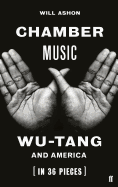
For Will Ashon--novelist (Clear Water, Heritage), record label founder and former music journalist--big questions and ambitious goals are familiar territory. His debut nonfiction book, Strange Labyrinth: Outlaws, Poets, Mystics, Murderers and a Coward in London's Great Forest, examined the Epping Forest and what it means to get lost. With Chamber Music: Wu-Tang and America (in 36 Pieces), he grounds his focus not in the mysteries of the English woods, but the enigmas of American hip hop.
In this remarkable project, Ashon explores the musical, political and social landscapes that helped shape the Wu-Tang Clan's 1993 debut album, Enter the Wu-Tang (36 Chambers). His central premises: "The genius of hip hop reaches some kind of wild, ramshackle apogee on Enter the Wu-Tang," and, "To come close to understanding that record is also to understand something about America."
Collectively, the pieces compose a portrait of an album and an era. Individually, the chambers (chapters by another name) provide three dozen deep dives into elements of the Wu-Tang story and Wu-Tang's America. The whole is akin to, as Ashon himself notes, a jigsaw puzzle; each piece feels distinct and different, together constituting something cohesive.
Ashon locates the album within the history of jazz, R&B, gospel and, most recently, hip hop. "Hip hop has often been treated as a collapse or retreat from the 'high' African American culture of modern jazz," he argues, "a kind of bastard offspring lacking the musicality, sophistication, complexity, even the spirituality or morality of its besuited forebear."
To better understand the landscapes from which the Wu-Tang Clan grew, Ashon explores Staten Island and the housing projects Stapleton and Park Hill. It was in these places that most of the group's nine members grew up and found themselves creating their own blended family. And here, in Ashon's reporting, location, lineage and politics bleed together. Members RZA, GZA and Ol' Dirty Bastard are first cousins, with shared heritage in the Cuffee family of the Shinnecock Indian Nation. Ashon writes at length about the Cuffees, and in particular the cousins' probable ancestor Fred Cuffee who was expelled from the Carlisle Indian School in 1892. The reason? "Too much negro."
Issues of hybridity, mixing and remixing play into the story of the Clan in myriad ways. In the chamber on the Shinnecock, Ashon wonders, "When it comes up against a totalizing system of categorization, does the very resistance of hybrid culture to easy classification operate as a broader cultural resistance? And isn't hip hop a hybrid culture, too--moreover, a culture of hybridity?"
Ashon is interested in inventories; he often takes stock of things by the numbers. He'll count the number of words in a song, or a section. He tallies the number of lines each member has on the record. He questions the efficacy of this method; still, it's especially informative as he examines the images of violence in the album. Ashon counts the references to guns and shooting; the mentions of "swords, blades, chopping, stabbing and slicing"; death itself; and uses of the words "dead, death, die and deadly." He considers how others might interpret the prevalence of this imagery--that, simply, the Wu-Tang Clan lived with guns, in a gun culture. But in the particularly compelling chamber "Thanatasia," Ashon makes a different argument; that Wu-Tang is, critically, instead creating a myth "whose job it is to... destabilize the dominant paradigm of 'reality'.... Perhaps in the same way that 'bad' comes to mean 'good,' so 'death' in the Wu-Tang's world actually comes to mean 'life' and the gun fires the silver bullets which bring breath back to the lungs of the undead."
Importantly, Ashon reckons with his own positioning as an English, white, Oxbridge-educated male. Given these facts, he decides, "This book shouldn’t exist." Or, at least, he decides that it's complicated to insert himself into it. However, his reflections on this matter make for some of his most thought-provoking and best writing. He interrogates not only his own ideas and roles within the music industry and society at large, but broader notions of capital-A Art and genius, and how to understand (or implode) them. And throughout, he broadens the conversation to include perspectives beyond his own, "sampling" sources from a wide spectrum of eras and fields: W.E.B. Du Bois, Edward Said, Kodwo Eshun, Bakari Kitwana, Ta-Nehisi Coates, Zadie Smith and countless more. He curates diverse perspectives, pulling scholars, thinkers, musicians and artists into the conversation--and he does it like an artist himself. His writing pulses and jumps. Some pieces flow into one another, while others pivot unexpectedly, suddenly, powerfully or playfully (as in the Kung Fu chamber. It's as fun as it sounds).
The members of the Wu-Tang Clan were not officially involved in the creation of the book. But even without the group's direct participation, anyone interested in better understanding hip hop and the history of one of its most fascinating groups will likely find this mosaic an enduring, worthy contribution--and even if Ashon might resist the word, a work of art. --Katie Weed

